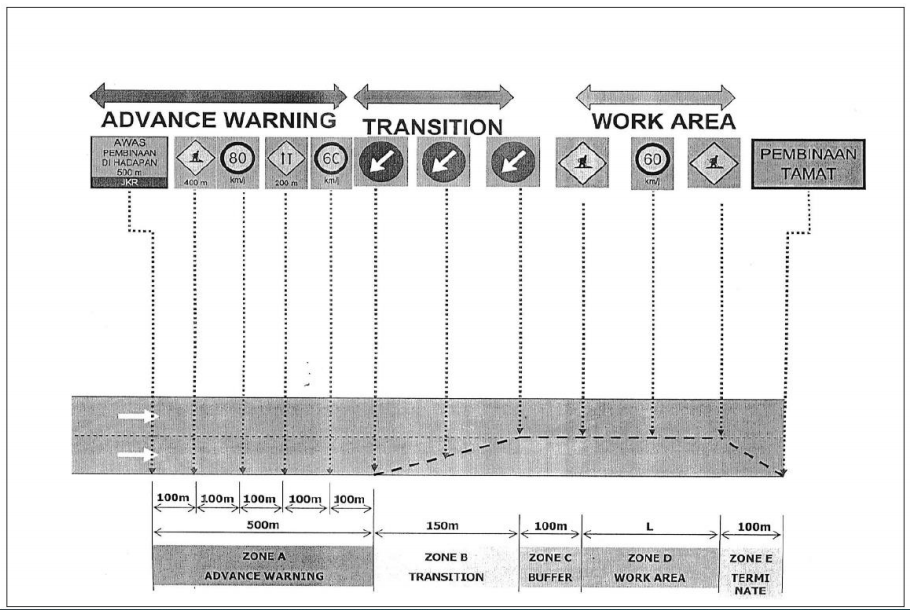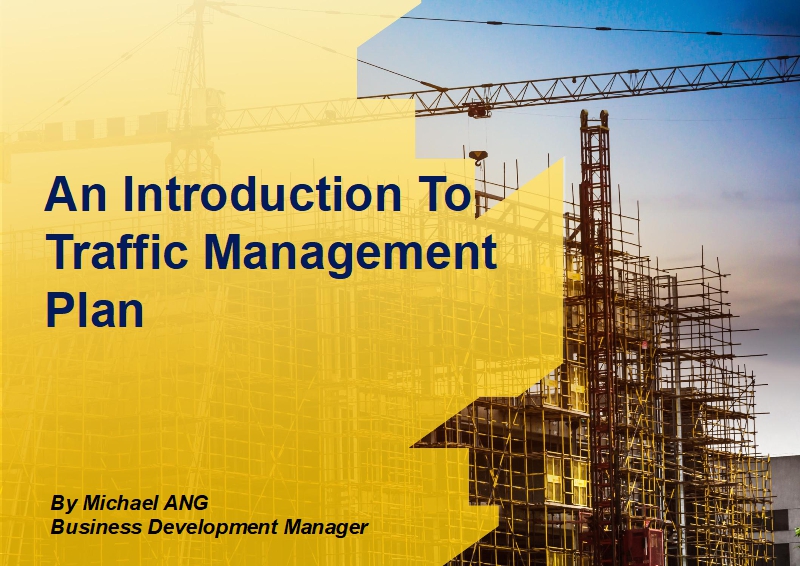Author: Michael ANG | 26 April, 2021
INTRODUCTION
A Traffic Management Plan (TMP) is defined as the planning of a process to control or facilitate vehicle movement that involves specific processes such as planning, geometry design, and traffic operation during the road construction or road upgrading works [1]. It is prepared before road works to ensure better traffic control for vehicles and pedestrians, to minimize traffic congestion, as well as to safeguard the site workers [2]. A proposed TMP shall be completed with the types and colour scheme of signage, cone and plastic barrier layout arrangements, and road closure methods, as required by the local authority.
Construction stages are decided during the planning stage and required to be reviewed to understand the stage complexity, duration for the activities, and the potential obstacles. Particulars that are required for detailed concern include [3]:
- Existing construction site rules and restriction
- Site location (whether on the road, road shoulder, or slope)
- Number of lanes required for road works
- Obstacles during road works, e.g. pipe services, drainage, etc
- Maximum distance allowable for work area
- Other requirements for normal traffic
TRAFFIC MANAGEMENT METHOD
There are four major traffic management methods used by Malaysian contractors to manage the traffic flow during road construction or upgrading works [1]:
a) Zoning Method
Reckless speeding creates hazards to site workers and other road users. Thus, work zoning shall be implemented to ensure road users drive with appropriate speed when crossing the construction area. It is a basic concept to be obeyed during road construction works. Generally, road construction area will be zoned to five zones to mitigate hazards:
- Zone A – Advance Warning Zone
Advance warning zone is essential in informing the road users of the upcoming road works. Users could have sufficient time to adjust their driving styles to suit the actual road conditions. This zoning shall be 2km before the site and need at least one blinker to notify road users. The warning signboards are also recommended in this zone. - Zone B – Transition Zone
Transition zone is an area where the road users are required to detour their vehicle from the road under construction to the detoured road to facilitate the road construction works. New and clear detouring signboards shall be allocated so that road users are well informed of the lane changes. - Zone C – Buffer Zone
Buffer zone is an empty area between the transition zone and the work zone. This zone acts as a safety buffer for both site workers and road users. This area allows for some careless drivers to slow down and change the driving lane in case if they had missed detouring in the transition zone. This area shall be free from any construction materials, machineries, or site vehicles. It is only allowed for road signage along with the zoning. - Zone D – Work Area Zone
Work area zone is an area when construction works are carried out and only exclusive for site workers, machineries, and construction materials. Road users and the public are restricted to the area. This is to avoid unwanted accidents that might delay the work progress. - Zone E – Terminate Zone
Terminate Zone is an area where the traffic is free from any construction works and the road conditions are back to normal. A signboard “PEMBINAAN TAMAT” (End of Construction) shall be put to notify users that the road conditions are back to normal and they are now allowed to drive at the normal speed that originally set.

Figure 1: Illustration of Each Zoning and the Overall Arrangement of Signboard [3].
b) Road Closure
Road maintenance and upgrading works are unavoidable to ensure road user experience. However, road works always linked to road closure that may increase traffic congestion in the affected area. Thus, it is crucial to properly plan the road closure to reduce the impacts on road users. In general, there are three road closure methods:
- Closure of two or more lanes in one travel direction without disturbance to the opposite travel direction.
- Crossover, which is an operation where one travel direction is closed and the opposite travel direction is operated as a two-way route.
- Closure of one or more lanes for a single-way route, with the balance lanes remain open for traffic flow.
c) Detour or Alternative Route
Alternative route is introduced if the road construction or upgrading works involved the whole stretch of road. This method is implemented to safeguard site workers from vehicle hazards that pass by the area. If the alternative route is near to the construction site, the vehicles shall be ensured to travel at a low speed by putting sufficient signboards as a reminder.
d) Night Work
Night work is also another effective method of working to overcome the traffic flow issues. Although the lower traffic flow at night eases the traffic congestion, some other risk factors are worth considering when conducting road works at night, e.g. reckless driver’s behavior, higher driving speed, tiredness, difficulty in distance judgement, and limited sight distance. Thus, contractors or site workers need to take necessary precautions such as wearing safety vest with proper light reflection, temporary spotlight, and machineries with amber flashing beacons.
CONCLUSION
An effective traffic management plan is achievable by considering various factors that will influence the traffic management at the site. The factors that must be taken into consideration are upgrading road size, potential site problems, works rate uncertainty, and the experience of the traffic management planner. The traffic management must be well planned so that the overall safety level and work productivity could be increased; consequently, the works could be completed in the expected time, cost, and quality.
Michael ANG
Business Development Manager
IPM Professional Services Sdn Bhd
References:
[1] M. S. A. Rahman (2010). Kaedah Pengurusan Trafik Semasa Kerja Menaiktaraf Jalan. Universiti Teknologi Malaysia : Projek Ijazah Sarjana Muda Sains Pembinaan. Retrieved from https://bic.utm.my/files/2018/04/KAEDAH-PENGURUSAN-TRAFIK-SEMASA-KERJA-MENAIKTARAF-JALAN_4.pdf
[2] Muhibah Traffic. Traffic Management Plan (TMP). https://trafikmuhibahholdings.wordpress.com/traffic-management-plan-tmp/
[3] A. Khalid (2009). Pengurusan Trafik Dalam Pembinaan Jalan Raya. Universiti Teknologi Malaysia : Projek Ijazah Sarjana Muda Kejuruteraan Awam. Retrieved from: https://kupdf.net/download/pengurusan-trafik-dalam-pembinaan-jalanrayapdf_596904dfdc0d60df08a88e78_pdf

